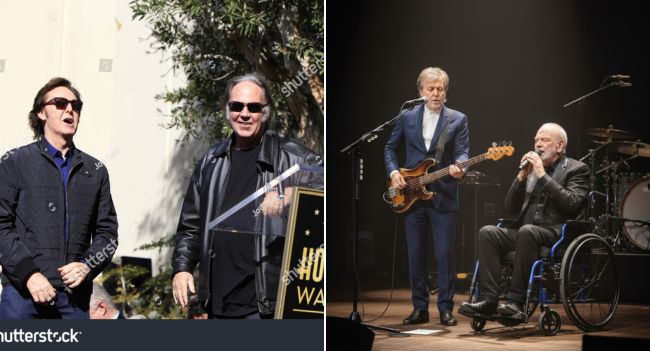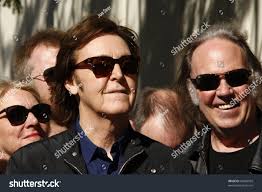
The studio was small, tucked into the Hollywood Hills, the kind that had seen a thousand dreams born and just as many fade. But that afternoon, it held something sacred — two men who had already lived every verse the world could offer.
Neil Diamond, 84, walked slowly toward the grand piano, his gait steady but gentle, every movement measured like a prayer. Across from him, Paul McCartney, 83, was tuning his Höfner bass, humming a few stray Beatles harmonies under his breath.
No entourage. No cameras. Just two voices, two legends, and a single piece of paper with a title written in shaky pen:
“When the Lights Slow Down.”

The Song That Wasn’t Supposed to Happen
It began as a letter — a quiet exchange between old friends who’d met only briefly in the 1970s, both too busy being worshipped to truly talk. Neil had written to Paul in early 2025, after hearing about his acoustic “McCartney III” sessions.
“You still sound like the morning,” Neil wrote.
“I think I’ve become the evening. Maybe we should meet in the middle.”
Paul replied with a note just as tender:
“Let’s write something the night can hum when we’re gone.”
And so, Songs of Forever was born — a small studio project meant to capture the voices of artists who had outlived their own fame. But this one song — the one they wrote together — changed everything.

Two Men, One Memory
They spent the first hour in silence. Neil played a few chords — soft, dusty, aching — while Paul scribbled lines in his old leather notebook. Then Paul looked up and said quietly,
“You ever miss being loud?”
Neil smiled. “Every day.”
Paul nodded. “Then let’s write that.”
And they did.
The song took shape like a confession: verses about empty arenas and quiet mornings, bridges about laughter that once filled tour buses, and a chorus so simple it felt eternal.
“We’re not gone, we’re just quieter now,
The noise has left, but the echoes stay somehow.”
By the time they finished the demo, neither spoke. The room was still except for the hum of the piano strings vibrating on their own.
The Recording — One Take, No Retakes
When the engineers pressed record, Neil insisted: no filters, no auto-correction, no overdubs. “Let it breathe,” he said. “Let them hear our bones.”
Paul laughed. “They already do, mate.”
In that single take, Paul’s voice floated like dawn — bright, trembling, still unbroken. Neil’s came in lower, rougher, but warm — the sound of a man who had wrestled time and finally made peace with it.
Midway through, Paul stopped, looked at Neil, and whispered, “You take it.”
Neil nodded and sang the bridge that became the heart of the song:
“I don’t need the spotlight’s shine,
I’ve got your face still lit in mine.”
Paul’s bass entered softly after that. It wasn’t just accompaniment — it was memory.
The Moment That Broke the Room
When the final line came — “We’re not gone, we’re just quieter now” — Paul reached over and laid his hand on Neil’s shoulder.
No one spoke. The sound engineer later said he had to step out of the booth because he was crying too hard to breathe.
They sat there a long while after the tape stopped. Neil finally said, “That’s the last song I’ll ever need.”
Paul smiled gently. “Then we did it right.”
The Release That Stopped Time
Weeks later, When the Lights Slow Down was released quietly online — no press run, no interviews. Just a single black-and-white photo of the two men, sitting beside a piano, with the caption:
“For everyone learning to say goodnight.”
Within 48 hours, it hit 50 million streams. Radio DJs around the world interrupted programming to play it in full. Fans called it “a love letter to growing old.”
Elton John tweeted, “If you ever doubted music could still heal, listen to this.”
Bruce Springsteen wrote: “Two voices that raised us — now whispering us home.”
A Whisper That Echoed
At the Grammys that year, the song received a standing ovation without either man attending. Their representatives said Neil watched from home in Denver, holding Katie’s hand.
When the final chorus played on screen, he closed his eyes and said softly, “That’s the sound of peace.”
Paul, speaking later in an interview, added:
“You spend your youth trying to be heard.
You spend your old age learning to listen.
Neil always listened.”
Epilogue — The Piano Still There
Months later, a journalist visiting the L.A. studio found the lyric sheet still taped to the piano.
At the top, in Neil’s handwriting, were three words underlined twice:
“Not an ending.”
And below Paul’s signature, a small note:
“Play it again when we’re gone.”
That’s the song the world didn’t know it needed —
not a goodbye, not even a memory —
just two voices, weathered and warm,
teaching the rest of us how to stay.
